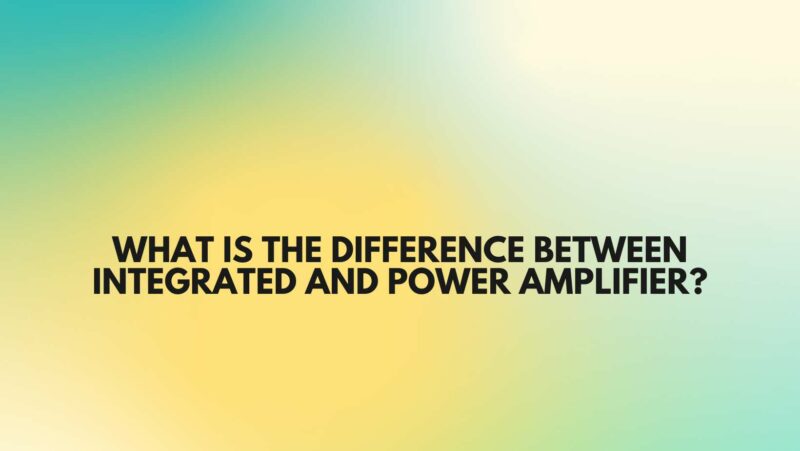In the realm of high-fidelity audio systems, amplifiers play a pivotal role in shaping your listening experience. When considering amplifiers, two primary categories often come into focus: integrated amplifiers and power amplifiers. While both serve the purpose of amplifying audio signals, they are distinct in design, function, and application. In this comprehensive article, we will delve into the fundamental differences between integrated amplifiers and power amplifiers to help you make an informed choice for your audio setup.
Integrated Amplifier: A Comprehensive Overview
An integrated amplifier, as the name suggests, integrates two critical components of an audio system – the preamplifier and the power amplifier – into a single unit. Let’s explore its defining features:
- All-in-One Design: Integrated amplifiers combine the preamplifier, responsible for processing input signals and adjusting their volume, with the power amplifier, which amplifies these signals to drive your speakers.
- Space Efficiency: Due to their compact and streamlined design, integrated amplifiers are space-efficient. They are an excellent choice for setups with limited space or those seeking simplicity.
- Cost-Effective: Integrated amplifiers are often more cost-effective than their power amplifier and separate preamp counterparts. This makes them an attractive option for budget-conscious audiophiles.
- Versatility: Integrated amplifiers come in various power ratings, catering to a wide range of speakers, from bookshelf to floor-standing models. They are versatile and suitable for most audio setups.
- Additional Features: Many integrated amplifiers offer built-in features such as Digital-to-Analog Converters (DACs), phono stages for turntables, and multiple input options, enhancing their usability and convenience.
- Sound Quality: High-quality integrated amplifiers can deliver impressive sound performance. While not always on par with high-end power amplifiers, they provide excellent sound quality for mid-range and entry-level setups.
Power Amplifier: An In-Depth Exploration
Power amplifiers, on the other hand, are designed with a singular focus: to amplify audio signals with precision and power. Let’s examine their defining characteristics:
- Specialized Amplification: Power amplifiers are dedicated solely to amplifying audio signals. They excel in providing clear and powerful amplification, often surpassing integrated amplifiers in this regard.
- Modularity: Power amplifiers offer modularity. You can pair them with a separate preamplifier to create a customized audio system, tailoring it to your specific sound preferences.
- Power Output: Power amplifiers generally deliver higher power output per channel compared to integrated amplifiers. This makes them suitable for driving demanding speakers or larger audio setups.
- Sound Quality: High-end power amplifiers are renowned for their exceptional sound quality. They deliver precise and transparent amplification with minimal coloration or distortion, making them a favorite among audiophiles.
- Minimal Features: Unlike integrated amplifiers, power amplifiers focus solely on amplification and lack additional features like DACs or built-in phono stages. Users may need separate components to fulfill these functions.
Choosing the Right Amplifier: Factors to Consider
Selecting between an integrated amplifier and a power amplifier hinges on several crucial factors:
- Space and Convenience: If you have limited space or seek a streamlined, all-in-one solution with added features, an integrated amplifier may be the preferred choice.
- Sound Quality: If you prioritize uncompromising sound quality and are willing to invest in a dedicated preamp, a high-quality power amplifier is likely the better option.
- Customization: If you appreciate the flexibility to customize your audio system or plan to expand it over time, a power amplifier offers greater modularity.
- Speaker Requirements: Consider the power requirements of your speakers. Power amplifiers are better suited for driving demanding speakers, while integrated amplifiers are versatile and can work with various speaker types.
- Budget: Your budget plays a significant role in your decision. Integrated amplifiers are generally more budget-friendly, while high-end power amplifiers can represent a substantial investment.
Conclusion
The choice between an integrated amplifier and a power amplifier is ultimately determined by your specific needs, preferences, and budget. Both amplifiers serve their purposes admirably and cater to different aspects of the audiophile experience. Carefully assess your requirements and prioritize what matters most to you in terms of space, features, sound quality, and customization to determine the amplifier type that will best elevate your listening journey. Whether you opt for the integrated simplicity or the dedicated power of a separate preamp/power amp setup, both choices offer the potential for an immersive and satisfying audio experience.


